One species that catches the eyes of many people in a local fish store is freshwater sharks. While they sound quite terrifying, they are not. In fact, they are interesting and brilliant freshwater fish to keep.
The types of sharks we are covering in this article do not resemble great white sharks, in fact, they are not technically sharks at all. We hope you have found this article useful and insightful. There is a lot to research and remember when thinking about adding sharks to an aquarium.
But, they are interesting fish to keep. We will be walking you through everything you will need to know about freshwater sharks, from the different types available, their diet, habitat, and size, to provide you with a complete guide to this species.
In addition to freshwater sharks, there are a select few saltwater sharks suitable for aquariums. So, if you were interested in learning about them, and have a saltwater tank large enough, you should take a look at our guide.
What is a Freshwater Shark?
Freshwater sharks are not actually sharks, nor are they part of the shark family. They are actually types of catfish and cyprinids. Their name derives from the shape of their silhouette, which does, in many ways, resemble a shark. Their tails are forked, and they also have dorsal fins that are pointed. When thinking about their temperament, they are not always the best tank mates, as they can be rather territorial.

In their natural habitats, freshwater sharks can be found in South America, Africa, China, and Southeast Asia. However, they are endangered in these areas. Given this, when you purchase these fish for your aquarium, they are bred in commercial fish farms.
Important Information and Freshwater Shark Tank Setup
When purchasing freshwater sharks, it is important to ensure you are carrying out the correct research prior to this. While they are a fairly easy fish to keep. There are a number of requirements that they need. You will need to ensure you have the correct size aquarium, and that you house them with suitable fish.
Much like pretty much all other fish, each subspecies of freshwater shark has its own personality and behavioural traits, some good, and some bad! For example, there are some freshwater sharks that are far more aggressive than others.
Freshwater Shark Size and Tank Size
One of the most important things you need to be aware of when purchasing freshwater sharks is their size. They are a particularly large breed of fish, and will quickly outgrow smaller tanks. This is why it is essential to ensure that you have sufficient room in your tank.
When sharks are initially purchased, they are fairly small. For fish keepers with little knowledge of this breed, they may not be aware of how large these fish will grow. They will not survive in a smaller tank, and you will need to be prepared to own a large aquarium.
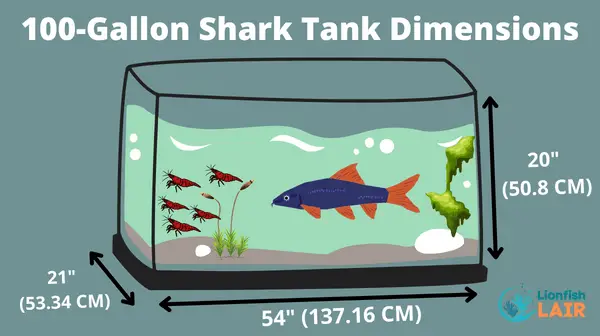
Ideally, you will need to be looking at tanks that are 100 gallons (454 liters) or more. This is often large enough to house one shark, which gives you a better idea of how large these fish grow. Additionally, it allows you to populate the tank with more than just sharks, plants, invertebrates and other fish.
While they take a couple of years to reach their full size, and they do vary in length slightly, you will need to keep their final size in mind. Some of these sharks can reach and even surpass 14 inches (35.5 cm) in length.
Habitat and Tank Requirements
The size of the tank is essential. While 100 gallons (454 liters) is the minimum requirement, we would recommend purchasing a larger tank where possible. In terms of substrate, because freshwater sharks swim in the middle to bottom areas of the tanks, sand is the best option.
Sand ensures that the sharks are free from injury, and will not harm themselves on sharper gravel. Sand is the most natural option. However, you can choose smaller gravel as an alternative if you want to avoid using sand.
The water temperature of the tank should be anywhere around 80°F (26.6°C). This is because they are tropical fish. Anything below this is not warm enough. This means that you will need to purchase a suitable heater for the tank.
For all types of fish, a filter is essential. As freshwater sharks require a larger tank, you will need to ensure that the filter you purchase is strong enough to remove all the waste from the water. You can choose to add ornaments, hiding spots, and plants if you wish too, this is tremendously beneficial to your fish.
Water Levels
With any type of aquarium, it is important to ensure that the water levels are correct. This means you should be regularly testing the water to ensure that it is free from ammonia, and nitrite. You will need to carry out weekly water tests to ensure that the water and pH levels are suitable for the sharks. This needs to be accompanied by regular water changes and filter management too.
When looking at the pH levels, they are typically within the range of 6.0 to 8.0. However, the exact levels needed will depend on the individual type of shark. Given this, you will need to carry out the correct research before purchasing. In addition to the pH levels, the levels of water hardness needed also varies.
While some will only need from 2dH to 10dH, others will need up to 20dH. Given this, you will need to ensure that these levels are correct before placing the shark into the tank. Always ensure that your tank is set up correctly and that the water levels are stable before placing the fish into the tank. This is because a shark will not survive if there are high and dangerous levels of ammonia present.
Feeding and Dietary Requirements
The feeding requirements for freshwater sharks is fairly simple. We would personally recommend a diet of dried fish food, with the occasional frozen food treat. When thinking about the correct type of food, you should choose pellets or tablets over flake food.
This is because the pellets and tablets will sink to the bottom of the tank, making it easier for the shark to eat. As sharks do not typically swim to the surface, they benefit from food that sink. We would recommend bottom feeder tablets, algae rounds, and fish pellets.
When looking at frozen food, you can choose to feed them blood worms every so often too. It is worth noting that some species of shark can be territorial and aggressive. Given this, if they are housed with smaller fish, there is a high possibility that they will eat them. They will also eat dead fish, and you will need to remove any out of the tank as soon as possible.
Different Types of Freshwater Sharks
There are many types of freshwater shark, and they all have their own characteristics and are slightly different from each other. We have discussed the most common and popular types of freshwater sharks you can purchase for your aquarium.
1. Epalzeorhynchos frenatum (Rainbow Shark)
One of the most common types of freshwater fish are rainbow shark. They are widely available in local fish stores. While they have rainbow in their name, this is slightly deceiving as they are fairly plain in their color.
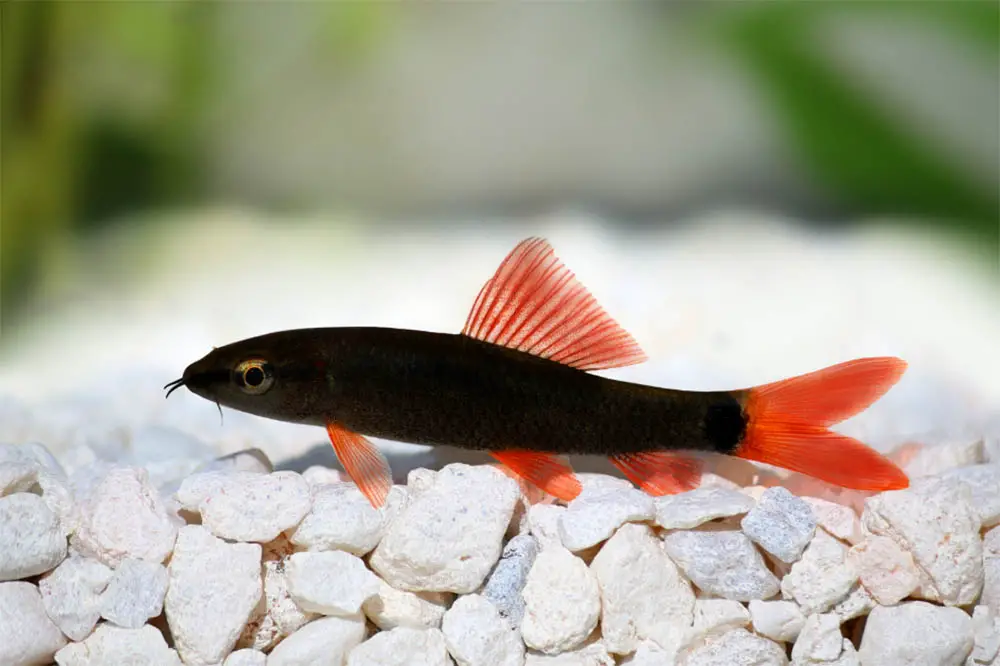
They resemble a red tail shark, but feature a red fin in addition to their tail being red. The color present will vary from bright red, to a pinker tone. The majority of their body is black. While the majority are black and red, there are a number of albino rainbow sharks available.
These are white with red fins and tails. These are created using selective breeding. Rainbow sharks are a semi-aggressive fish. Given this, we would not recommend housing them with smaller fish. They are best suited when kept with larger fish that they cannot bully.
You should not add any other sharks to the tank with a rainbow fish as they will fight and this will lead to injury that can be avoided. They are easy to keep on the whole, and follow an omnivore diet. They reach around 6 inches (15.62 cm) in lenth, and require a tank that is at least 30 gallons (113.5 liters) in size.
2. Epalzeorhynchos bicolor (Red Tail Shark)
Red tail sharks are another common choice for tropical home aquariums. As we have discussed, they are similar to rainbow sharks in color. They are all black, and have a bold red tail that is quite striking. Their fin also has a small white spot. This type of shark originates from Thailand, and is a type of shark that is unfortunately near extinct in its natural habitat.
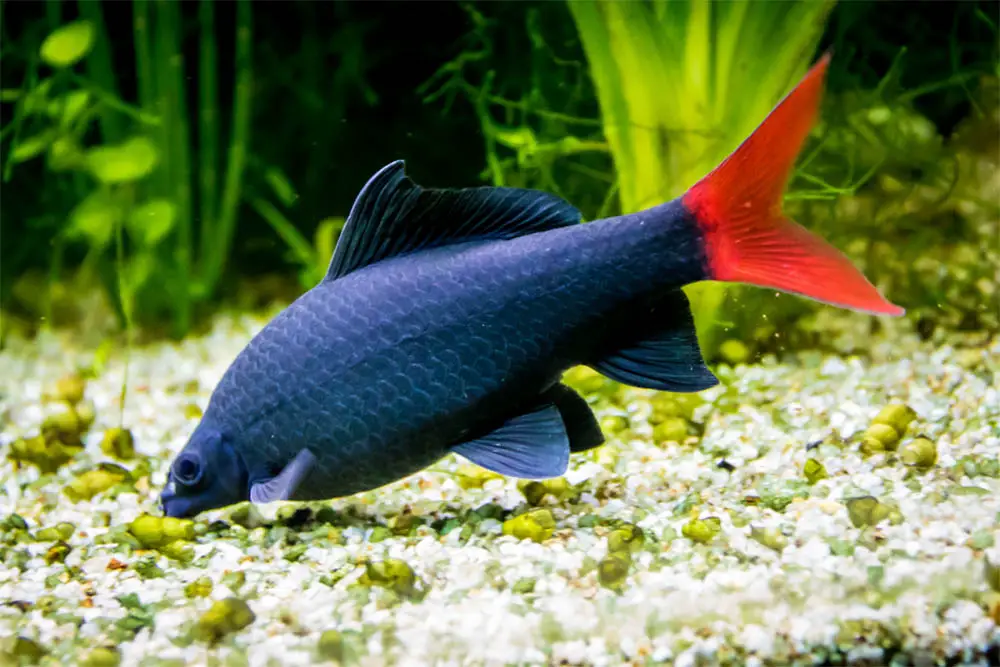
While red tail sharks are a great addition to a tank, you need to be extremely careful with the types of fish it is housed with. This species can be particularly aggressive. As they are semi aggressive, you should not place them into a tank with slow moving fish, because they are fin nippers.
In addition to this, they have a tendency to attack other bottom feeders, such as catfish. They must not be kept with other red tail sharks, as they will attack and injure them. This species follows an omnivore diet, and is moderately difficult to keep. Given this, if you are a beginner, we would recommend purchasing a rainbow shark to begin with, instead of a red tail. They need a tank that is also 30 gallons (113.5 liters) in size.
3. Sahyadria denisonii (Rosaline Shark)
Rosaline sharks are one of the more beautiful options. They have red and blue stripes, and yellow patterns along their tail. It is easy to see why they are a popular choice. In addition to this, they are fairly easy to keep too. They are not overly large, and will only grow to around 4 inches (10.16 cm) in length. As a result, if you have a smaller home aquarium but still want to own a shark, this type could be a great option to consider.
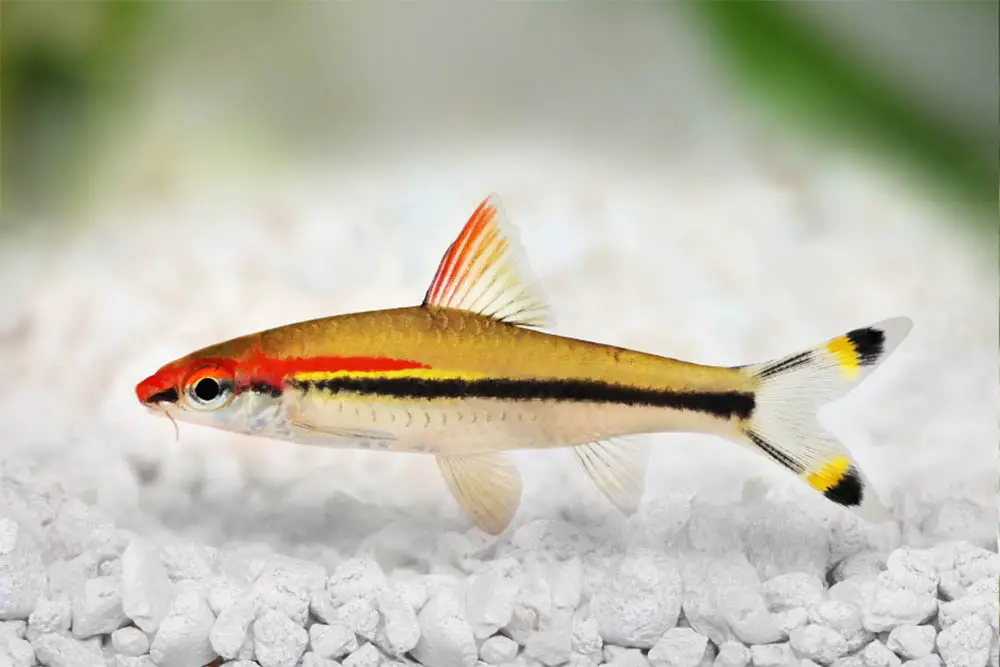
They are one of the few types of shark that prefer to live in a school, rather than alone. Given this, it is recommended that you purchase around six or more of these fish to live together. Rosaline sharks require a 30 gallon (113.5 liters) tank at the least, and they are a peaceful fish.
This means you should not have too much trouble when housing these fish with other tank mates. They are omnivores. As they are easy to keep, they are a perfect option for beginners. We would recommend purchasing captive bred Rosaline because they are an endangered species in their natural habitat in India.
4. Ariopsis seemanni (Columbian Shark)
Columbian sharks are a very peaceful type of shark that are moderately easy to keep. However, they are predatory, and have venomous spines. Given this, you will need to proceed with caution if you need to place your hands inside the tank.
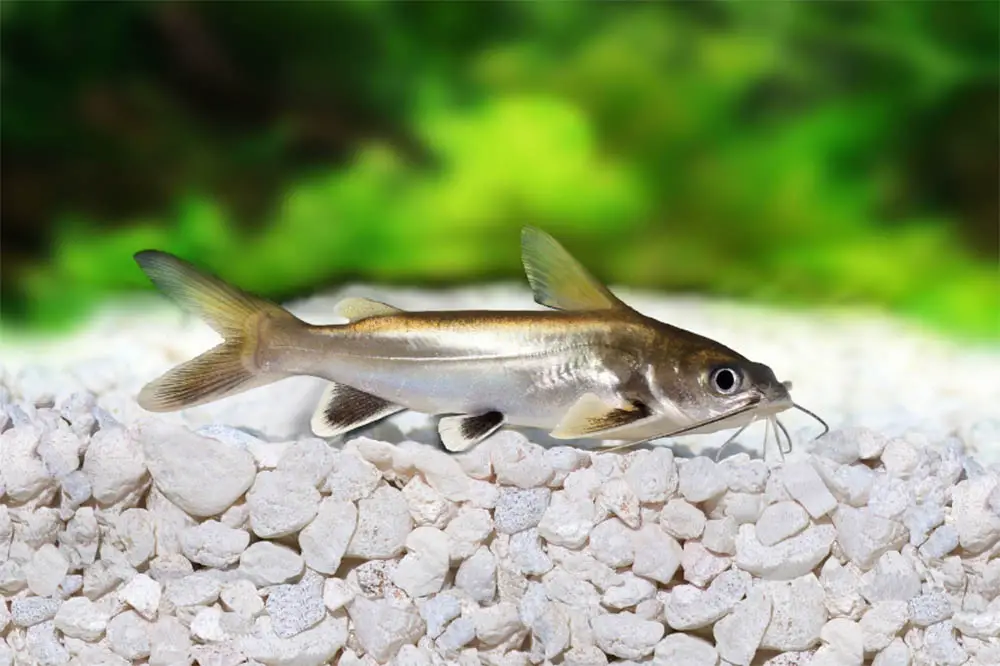
This is why many beginners will choose to avoid this species. However, when cared for correctly, they are not too difficult to manage. They will eat smaller tank mates, so you will only want to keep them with larger fish. In addition to this, they are a shoaling fish, and should not be kept alone.
In terms of tank size, around 75 gallons (340.9 liters) is sufficient as they do not grow too large. They also need to be placed into a saltwater tank when they reach maturity. Saltwater tanks are more difficult to maintain, which may be more of an issue for beginners.
5. Pangasionodon hypophthalmus (Iridescent Shark)
Iridescent sharks are beautiful to look at, but they are not easy to keep. Their difficulty level is high, and because of this, they are not recommended for beginners. This difficulty level is not linked to their temperament. Surprisingly, they are a peaceful type of freshwater shark.
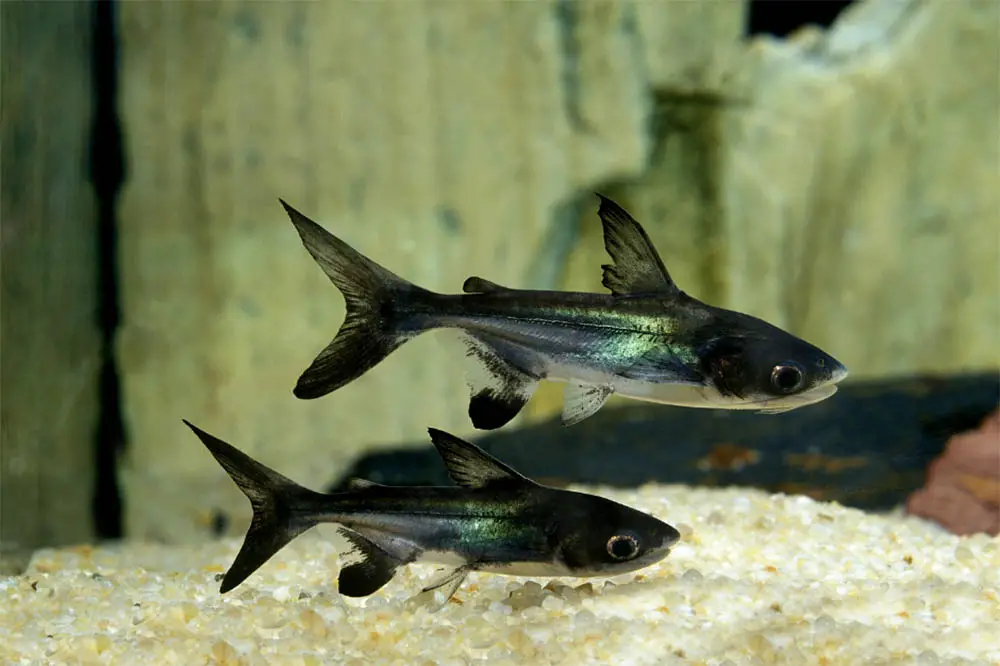
They are a difficult shark to keep due to their size. It is rare that a fish owner will have sufficient room to house this shark because they will grow to 36 inches (91.44 cm) when they reach maturity. While many pet stores will sell iridescent sharks, only a select few people will have a suitable tank for this fish.
The tank size you will need at a minimum is 300 gallons (1,363.83 liters), but a tank bigger than this is the more suitable option. Iridescent sharks are beautiful, with their purple black color, and specks of white. They are not overly expensive to purchase, and follow an omnivore diet. However, you will need to ensure the correct environment to safely house them.
6. Labeo chrysophekadion (Black Sharkminnow)
Black sharkminnow are a type of freshwater shark that we would not necessarily recommend purchasing. This is because of how big they grow. As an adult they will reach up to 24 inches (609.6 cm), which would require a tank that is 180 gallons (681.37) for this shark alone.
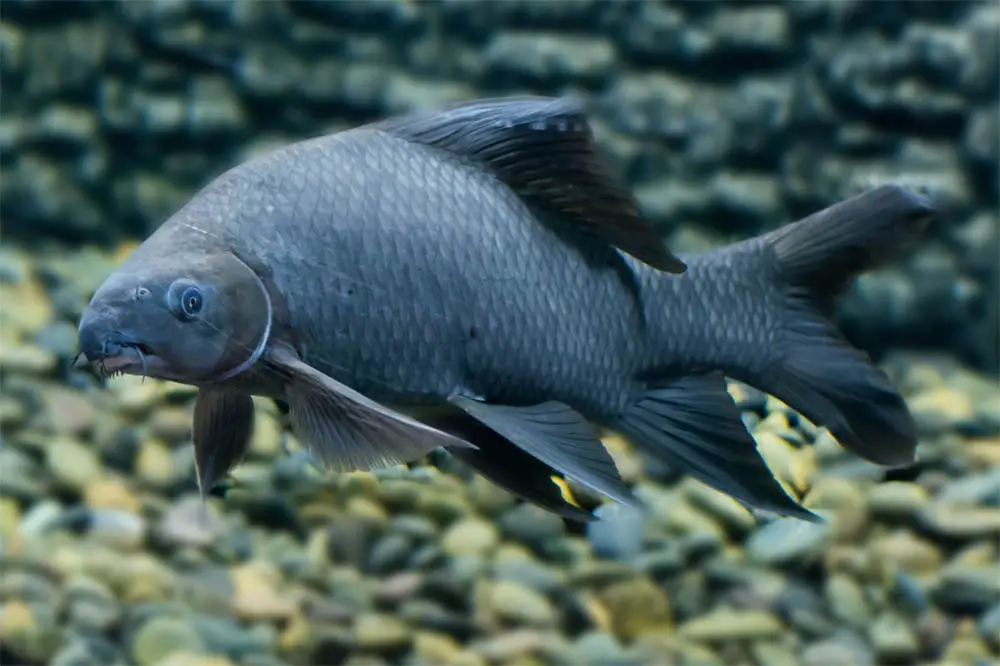
This is why this is a moderately difficult shark to keep. They are also semi aggressive, and you will need to purchase fast fish to keep in the same tank as they are fin nippers. You should add this shark to your tank last as they can be rather territorial. They have an omnivore diet, and are typically purple to black in color. Though there are albino options available. They have longer fins in comparison to some of the other types of shark
7. Myxocyprinus asiaticus (Chinese High-Fin Branded Shark)
The Chinese high-fin branded sharks are one of the more interesting varieties. They are black and white striped, and feature a long fin. While they are an interesting fish, they are one of the more difficult shark species to keep.
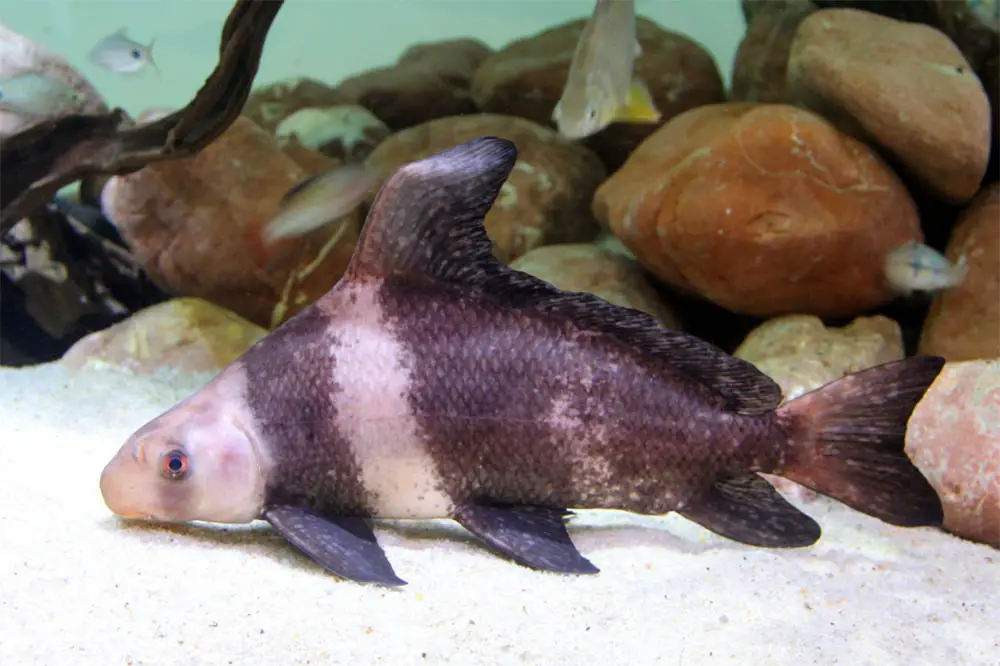
While they may be peaceful, they require a very large tank, which needs to be at least 300 gallons (1,363.83 liters). This is not achievable for the majority of people, and as a result would be an unsuitable shark to own.
8. Balantiocheilos melanopterus (Bala Shark)
The Bala Shark is another type you will need to ensure that you have enough space for. As they grow to over 12 inches (30.4 cm) in length, you will need a tank that is around 150 gallons (681.9 liters) at the smallest. In general, they are a fairly peaceful shark to own, and they are not too difficult to keep.
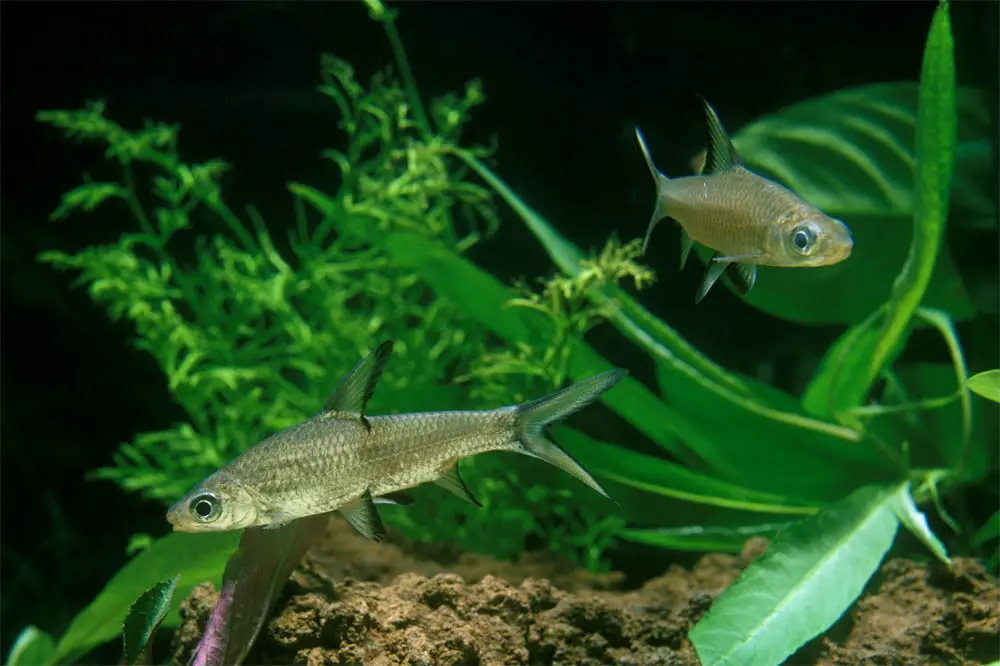
They are a fairly popular option, but due to their shoaling nature, they will need to be kept with other Bala sharks. Given this, you will need a substantial amount of room for a large aquarium. Out of all the different types of shark, they are known to be rather skittish, and can try to jump out of the tank which is important to keep in mind. They follow an omnivore diet.
Final Thoughts
We hope you have found this article useful. There are a lot of aspects to research and remember when thinking about adding sharks to an aquarium. Given this, we would recommend choosing wisely before purchasing. While they are a fantastic type of fish to own, there are many things you will need to take into consideration.

